A Novel Method for Estimating Biomass and Carbon Sequestration in Tropical Rainforest Areas Based on Remote Sensing Imagery: A Case Study in the Kon Ha Nung Plateau, Vietnam
Abstract
:1. Introduction
2. Materials and Methods
2.1. Study Area
- +
- To the north by Kon Plong district (Kon Tum province);
- +
- To the east by Quang Ngai and Binh Dinh provinces;
- +
- To the south by An Khe town and Dak Po district, Gia Lai province;
- +
- To the west by Chu Păh district, Gia Lai province.
2.2. Materials
2.2.1. Satellite Image Data
2.2.2. Standard Cells for Forest Investigation
2.3. Methods
2.3.1. Research Process
2.3.2. Selecting the Formula and Specifying Parameters for the Model
Weighting for Forest Types
Determination of the EVI Based on Remote Sensing Data
Defining the Biomass Regression Models
Verification of the Model Accuracy
2.3.3. Method of Determining Carbon Reserves
3. Results
3.1. Determination of the EVI Based on Sentinel-2 Satellite Images
3.2. Defining the Biomass Estimation Model
3.2.1. Biomass Estimation Model for 2016
3.2.2. Biomass Estimation Model for 2021
3.3. Mapping the Estimated Biomass Value and Natural Forest Carbon Reserves in the Kon Ha Nung Plateau Area
4. Discussion
4.1. Estimation of Tropical Rainforest Biomass Based on Remote Sensing Data
4.2. Status Quo and Fluctuations of Biomass in the Kon Ha Nung Plateau Area for the Period 2016–2021
5. Conclusions
Author Contributions
Funding
Institutional Review Board Statement
Informed Consent Statement
Data Availability Statement
Acknowledgments
Conflicts of Interest
References
- Ollinger, S. Forest Ecosystems. In Encyclopedia of Life Sciences; Nature Publishing Group: London, UK, 2003. [Google Scholar]
- Jim, C.Y. Effect of vegetation biomass structure on thermal performance of tropical green roof. Landsc. Ecol. Eng. 2012, 8, 173–187. [Google Scholar] [CrossRef] [Green Version]
- Corlett, R.; Primack, R. Tropical Rain Forests: An Ecological and Biogeographical Comparison, 2nd ed.; John Wiley and Sons: Hoboken, NJ, USA, 2011. [Google Scholar]
- Brown, S.; Gillespie, A.; Lugo, A. Biomass Estimation Methods for Tropical Forests with Applications to Forest Inventory Data. For. Sci. 1989, 35, 881–902. [Google Scholar]
- Brown, S. Estimating Biomass and Biomass Change of Tropical Forests: A Primer; FAO Forester Paper; FAO: Rome, Italy, 1997; Volume 134. [Google Scholar]
- Brown, S. Measuring carbon in forests: Current status and future challenges. Environ. Pollut. 2002, 116, 363–372. [Google Scholar] [CrossRef] [PubMed]
- Macdicken, K. A Guide to Monitoring Carbon Storage in Forestry and Agroforestry Projects; Winrock International Institute for Agricultural Development: Little Rock, AR, USA, 1997. [Google Scholar]
- Ketterings, Q.; Coe, R.; Van Noordwijk, M.; Ambagau’, Y.; Palm, C. Reducing uncertainty in the use of allometric biomass equations for predicting above-ground tree biomass in mixed secondary forest. For. Ecol. Manag. 2001, 146, 199–209. [Google Scholar] [CrossRef]
- Houghton, R. Aboveground Forest Biomass and the Global Carbon Balance. Glob. Chang. Biol. 2005, 11, 945–958. [Google Scholar] [CrossRef]
- Henry, M.; Besnard, A.; Asante, W.; Eshun, J.; Adu-Bredu, S.; Valentini, R.; Bernoux, M.; Saint-Andre, L. Wood density, phytomass variations within and among trees, and allometric equations in a tropical rainforest of Africa. For. Ecol. Manag. 2010, 260, 1375–1388. [Google Scholar] [CrossRef]
- Henry, M.; Cifuentes, M.; Réjou-Méchain, M.; Piotto, D.; Michel, J.M.; Wayson, C.; Alice Guier, F.; Lombis, H.; Castellanos, E.; Lara, R.; et al. Recommendations for the use of tree models to estimate national forest biomass and assess their uncertainty. Ann. For. Sci. 2015, 72, 769–777. [Google Scholar] [CrossRef] [Green Version]
- Raj, A.; Jhariya, M.K. Site quality and vegetation biomass in the tropical Sal mixed deciduous forest of Central India. Landsc. Ecol. Eng. 2021, 17, 387–399. [Google Scholar] [CrossRef]
- Chave, J.; Andalo, C.; Brown, S.; Cairns, M.; Chambers, J.; Eamus, D.; Fölster, H.; Fromard, F.; Higuchi, N.; Kira, T.; et al. Tre allometry and improved estimation of carbon stocks and balance in tropical forests. Oecologia 2005, 145, 87–99. [Google Scholar] [CrossRef] [PubMed]
- Chave, J.; Réjou-Méchain, M.; Burquez, A.; Chidumayo, E.; Colgan, M.; Delitti, W.; Duque, A.; Eid, T.; Fearnside, P.; Goodman, R.; et al. Improved allometric models to estimate the aboveground biomass of tropical trees. Glob. Change Biol. 2014, 20, 3177–3190. [Google Scholar] [CrossRef] [PubMed]
- Temesgen, H.; Goerndt, M.; Johnson, G.; Adams, D.; Monserud, R. Forest Measurement and Biometrics in Forest Management: Status and Future Needs of the Pacific Northwest USA. J. For. 2007, 105, 233–238. [Google Scholar]
- Temesgen, H.; Affleck, D.; Poudel, K.; Gray, A.; Sessions, J. A Review of the Challenges and Opportunities in Estimating Above Ground Forest Biomass Using Tree-Level Models. Scand. J. For. Res. 2015, 30, 326–335. [Google Scholar] [CrossRef]
- Zhang, L. Cross-Validation of Non-Linear Growth Functions for Modeling Tree Height-Diameter Relationships. Ann. Bot. 1997, 79, 251–257. [Google Scholar] [CrossRef] [Green Version]
- Picard, R.; Cook, R. Cross-Validation of Regression Models. J. Am. Stat. Assoc. 1984, 79, 575–583. [Google Scholar] [CrossRef]
- Lu, D. Aboveground biomass estimation using Landsat TM data in the Brazilian Amazon. Int. J. Remote Sens. 2005, 26, 2509–2525. [Google Scholar] [CrossRef]
- Nelson, R.; Kimes, D.; Salas, W.; Routhier, M. Secondary Forest Age and Tropical Forest Biomass Estimation Using Thematic Mapper Imagery. BioScience 2009, 50, 419–431. [Google Scholar] [CrossRef] [Green Version]
- Steininger, M. Satellite estimation of tropical secondary forest above-ground biomass: Data from Brazil and Bolivia. Int. J. Remote Sens. 2000, 21, 1139–1157. [Google Scholar] [CrossRef]
- Zheng, D.; Rademacher, J.; Chen, J.; Crow, T.; Bresee, M.; Moine, J.; Ryu, S. Estimating aboveground biomass using Landsat 7 ETM+ data across a managed landscape in northern Wisconsin, USA. Remote Sens. Environ. 2004, 93, 402–411. [Google Scholar] [CrossRef]
- Rosillo-Calle, F.; Woods, J. The Biomass Assessment Handbook; Routledge: London, UK, 2012. [Google Scholar]
- Natarajan, K.; Latva-Käyrä, P.; Zyadin, A.; Pelkonen, P. New methodological approach for biomass resource assessment in India using GIS application and land use/land cover (LULC) maps. Renew. Sustain. Energy Rev. 2016, 63, 256–268. [Google Scholar] [CrossRef]
- Zyadin, A.; Natarajan, K.; Latva-Käyrä, P.; Igliński, B.; Iglińska, A.; Trishkin, M.; Pelkonen, P.; Pappinen, A. Estimation of surplus biomass potential in southern and central Poland using GIS applications. Renew. Sustain. Energy Rev. 2018, 89, 204–215. [Google Scholar] [CrossRef]
- Nguyen, L.D.; Nguyen, C.T.; Le, H.S.; Tran, B.Q. Mangrove Mapping and Above-Ground Biomass Change Detection using Satellite Images in Coastal Areas of Thai Binh Province, Vietnam. For. Soc. 2019, 3, 248–261. [Google Scholar] [CrossRef]
- Li, T.; Mausel, P.; Brondízio, E.; Deardorff, D. A framework for creating and validating a non-linear spectrum-biomass model to estimate the secondary succession biomass in moist tropical forests. ISPRS J. Photogramm. Remote Sens. 2010, 65, 241–254. [Google Scholar] [CrossRef]
- Lu, D.; Mausel, P.; Brondízio, E.; Moran, E. Relationships between forest stand parameters and Landsat TM spectral responses in the Brazilian Amazon Basin. For. Ecol. Manag. 2004, 198, 149–167. [Google Scholar] [CrossRef]
- Lu, D.; Chen, Q.; Wang, G.; Moran, E.; Batistella, M.; Zhang, M.; Vaglio Laurin, G.; Saah, D. Aboveground Forest Biomass Estimation with Landsat and LiDAR Data and Uncertainty Analysis of the Estimates. Int. J. For. Res. 2012, 2012, 436537. [Google Scholar] [CrossRef] [Green Version]
- Kronseder, K.; Ballhorn, U.; Boehm, H.-D.; Siegert, F. Above ground biomass estimation across forest types at different degradation levels in Central Kalimantan using LiDAR data. Int. J. Appl. Earth Obs. Geoinf. 2012, 18, 37–48. [Google Scholar] [CrossRef]
- Næsset, E. Effects of different flying altitudes on biophysical stand properties estimated from canopy height and density measured with a small foot-print airborne scanner. Remote Sens. Environ. 2004, 91, 243–255. [Google Scholar] [CrossRef]
- Lim, K.; Treitz, P. Estimation of above ground forest biomass from airborne discrete return laser scanner data using canopy-based quantile estimators. Scand. J. For. Res. 2004, 19, 558–570. [Google Scholar] [CrossRef] [Green Version]
- Yang, B.; Zhang, Y.; Mao, X.; Lv, Y.; Shi, F.; Li, M. Mapping Spatiotemporal Changes in Forest Type and Aboveground Biomass from Landsat Long-Term Time-Series Analysis—A Case Study from Yaoluoping National Nature Reserve, Anhui Province of Eastern China. Remote Sens. 2022, 14, 2786. [Google Scholar] [CrossRef]
- Wang, L.; Sousa, W. Distinguishing mangrove species with laboratory measurements of hyperspectral leaf reflectance. Int. J. Remote Sens. 2009, 30, 1267–1281. [Google Scholar] [CrossRef]
- Sharma, S.B.; Kumar, S.; Hegde, N. Biomass and carbon recovery of secondary forest in a Montane Subtropical Forest of North Eastern India. Trop. Ecol. 2022, 1–8. [Google Scholar] [CrossRef]
- Do, T.V.; Yamamoto, M.; Kozan, O.; Hai, V.; Phung, D.; Thang, N.; Hai, L.; Nam, V.; Trieu, H.; Hoang, T.; et al. Ecoregional variations of aboveground biomass and stand structure in evergreen broadleaved forests. J. For. Res. 2019, 31, 1713–1722. [Google Scholar] [CrossRef] [Green Version]
- Gibbs, H.; Brown, S.; Niles, J.; Foley, J. Monitoring and estimating tropical forest carbon stocks: Making REDD a reality. Environ. Res. Lett. 2007, 2, 045023. [Google Scholar] [CrossRef]
- Pandian, E.; Parthasarathy, N. Decadal (2003–2013) changes in liana diversity, abundance and aboveground biomass in four inland tropical dry evergreen forest sites of peninsular India. J. For. Res. 2015, 27, 133–146. [Google Scholar] [CrossRef]
- Wanyonyi, P.; Tsingalia, M.; Omayio, D.; Mzungu, E. Evidence of Climate Changes in a Tropical Rainforest: Case Study Kakamega Tropical Rainforest. Int. J. Environ. Clim. Change 2021, 11, 202–2012. [Google Scholar] [CrossRef]
- Mauya, E.; Madundo, S. Aboveground biomass and carbon stock of usambara tropical rainforests in Tanzania. Tanzan. J. For. Nat. Conserv. 2021, 90, 63–82. [Google Scholar]
- Foody, G.; Curran, P. Estimation of Tropical Forest Extent and Regenerative Stage Using Remotely Sensed Data. J. Biogeogr. 1994, 21, 223. [Google Scholar] [CrossRef]
- Institute of Ecology and Biological Resources. Building a Profile of the World Biosphere Reserve on the Kon Ha Nung Plateau; People’s Committee of Gia Lai Province: Pleiku, Vietnam, 2020. [Google Scholar]
- Quynh, H. Geographical basic for management and sustainable using and environment protection of Kon Ka Kinh national park, Gia Lai province. Vietnam J. Earth Sci. 2014, 36, 175–183. [Google Scholar] [CrossRef]
- Do, H.; Grant, J.; Bon, T.; Zimmer, H.; Nichols, J. Diversity depends on scale in the forests of the Central Highlands of Vietnam. J. Asia-Pac. Biodivers. 2017, 10, 472–488. [Google Scholar] [CrossRef]
- Nguyen Dang, H. Features of Anthroprogenic Landscape Kon Ka Kinh National Park and Its Vicinity; Vietnam—Russian Tropical Center: Hanoi, Vietnam, 2017. [Google Scholar]
- Jinru, X.; Su, B. Significant Remote Sensing Vegetation Indices: A Review of Developments and Applications. J. Sens. 2017, 2017, 1353691. [Google Scholar] [CrossRef] [Green Version]
- Liu, H.Q.; Huete, A.R. A feedback based modification of the NDVI to minimize canopy background and atmospheric noise. IEEE Trans. Geosci. Remote Sens. 1995, 33, 457–465. [Google Scholar] [CrossRef]
- Gujarati, D. Econometrics by Example; Bloomsbury Publishing: London, UK, 2014. [Google Scholar]
- Applied Statistics. Lesson 5: Correlation Coefficients. Available online: http://www.andrews.edu/~calkins/math/edrm611/edrm05.htm (accessed on 18 July 2005).
- Li, D.; Wang, C.; Hu, Y.; Liu, S. General review on remote sensing-based biomass estimation. Geomat. Inf. Sci. Wuhan Univ. 2012, 37, 631–635. [Google Scholar]
- Wei, X. Biomass Estimation: A Remote Sensing Approach. Geogr. Compass 2010, 4, 1635–1647. [Google Scholar] [CrossRef]
- Gao, L.; Chai, G.; Zhang, X. Above-Ground Biomass Estimation of Plantation with Different Tree Species Using Airborne LiDAR and Hyperspectral Data. Remote Sens. 2022, 14, 2568. [Google Scholar] [CrossRef]
- Safari, A.; Sohrabi, H.; Powell, S. Comparison of satellite-based estimates of aboveground biomass in coppice oak forests using parametric, semiparametric, and nonparametric modeling methods. J. Appl. Remote Sens. 2018, 12, 046026. [Google Scholar] [CrossRef]
- Fonseca, G.; Soares, V.; Leite, H.; Ferraz, A.; Ribeiro, C.; Lorenzon, A.; Marcatti, G.; Teixeira, T.; Castro, N.; Mota, P.; et al. Artificial neural networks on integrated multispectral and SAR data for high-performance prediction of eucalyptus biomass. Comput. Electron. Agric. 2020, 168, 105089. [Google Scholar] [CrossRef]
- Galeana-Pizaña, J.; Núñez, J.M.; Corona, N. Remote Sensing-Based Biomass Estimation. In Evironmental Applications of Remote Sensing; IntechOpen: London, UK, 2016. [Google Scholar]
- Wu, C.; Shen, H.; Wang, K.; Shen, A.; Deng, J.; Gan, M. Landsat Imagery-Based Above Ground Biomass Estimation and Change Investigation Related to Human Activities. Sustainability 2016, 8, 159. [Google Scholar] [CrossRef] [Green Version]
- Vinué-Visús, D.; Ruiz-Peinado, R.; Fuente, D.; Oliver-Villanueva, J.-V.; Coll-Aliaga, E.; Lerma-Arce, V. Biomass Assessment and Carbon Sequestration in Post-Fire Shrublands by Means of Sentinel-2 and Gaussian Processes. Forests 2022, 13, 771. [Google Scholar] [CrossRef]
- Yu, Y.; Pan, Y.; Yang, X.; Fan, W. Spatial Scale Effect and Correction of Forest Aboveground Biomass Estimation Using Remote Sensing. Remote Sens. 2022, 14, 2828. [Google Scholar] [CrossRef]
- Matasci, G.; Hermosilla, T.; Wulder, M.; White, J.; Coops, N.; Hobart, G.; Bolton, D.; Tompalski, P.; Bater, C. Three decades of forest structural dynamics over Canada’s forested ecosystems using Landsat time-series and lidar plots. Remote Sens. Environ. 2018, 216, 697–714. [Google Scholar] [CrossRef]
- Wang, X.; Liu, C.; Lv, G.; Xu, J.; Cui, G. Integrating Multi-Source Remote Sensing to Assess Forest Aboveground Biomass in the Khingan Mountains of North-Eastern China Using Machine-Learning Algorithms. Remote Sens. 2022, 14, 1039. [Google Scholar] [CrossRef]
- Wang, F.; Yang, M.; Ma, L.; Zhang, T.; Qin, W.; Li, W.; Zhang, Y.; Sun, Z.; Wang, Z.; Li, F.; et al. Estimation of Above-Ground Biomass of Winter Wheat Based on Consumer-Grade Multi-Spectral UAV. Remote Sens. 2022, 14, 1251. [Google Scholar] [CrossRef]
- Freitas Silva, Y.; Valadares, R.; Werner, J.; Figueiredo, G.; Campbell, E. Spatial analysis of aboveground biomass and the enhanced vegetation index. In Proceedings of the AGU Fall Meeting, San Francisco, CA, USA, 9–13 December 2019. [Google Scholar]
- Garroutte, E.; Hansen, A.; Lawrence, R. Using NDVI and EVI to Map Spatiotemporal Variation in the Biomass and Quality of Forage for Migratory Elk in the Greater Yellowstone Ecosystem. Remote Sens. 2016, 8, 404. [Google Scholar] [CrossRef] [Green Version]
- Munyati, C. Detecting the distribution of grass aboveground biomass on a savannah rangeland using Sentinel-2 MSI vegetation indices. Adv. Space Res. 2021, 69, 1130–1145. [Google Scholar] [CrossRef]
- El Hajj, M.; Baghdadi, N.; Fayad, I.; Vieilledent, G.; Bailly, J.-S.; Ho Tong Minh, D. Interest of Integrating Spaceborne LiDAR Data to Improve the Estimation of Biomass in High Biomass Forested Areas. Remote Sens. 2017, 9, 213. [Google Scholar] [CrossRef]
- Liao, Z.; He, B.; Quan, X.; van Dijk, A.; Qiu, S.; Yin, C. Biomass estimation in dense tropical forest using multiple information from single-baseline P-band PolInSAR data. Remote Sens. Environ. 2019, 221, 489–507. [Google Scholar] [CrossRef]
- Grebner, D.; Bettinger, P.; Siry, J.; Boston, K. Forest policies and external pressures. In Introduction to Forestry and Natural Resources; Academic Press: Cambridge, MA, USA, 2022; pp. 365–386. [Google Scholar]
- Thuy, P.T.; Chau, N.H.; Chi, D.T.L.; Long, H.T.; Fisher, M.R. The politics of numbers and additionality governing the national Payment for Forest Environmental Services scheme in Vietnam: A case study from Son La province. For. Soc. 2020, 4, 379–404. [Google Scholar] [CrossRef]
- Ngo, T.T.H.; Nguyen, T.P.M.; Duong, T.H.; Ly, T.H. Forest—Related Culture and Contribution to Sustainable Development in the Northern Mountain Region in Vietnam. For. Soc. 2021, 5, 32–47. [Google Scholar] [CrossRef]
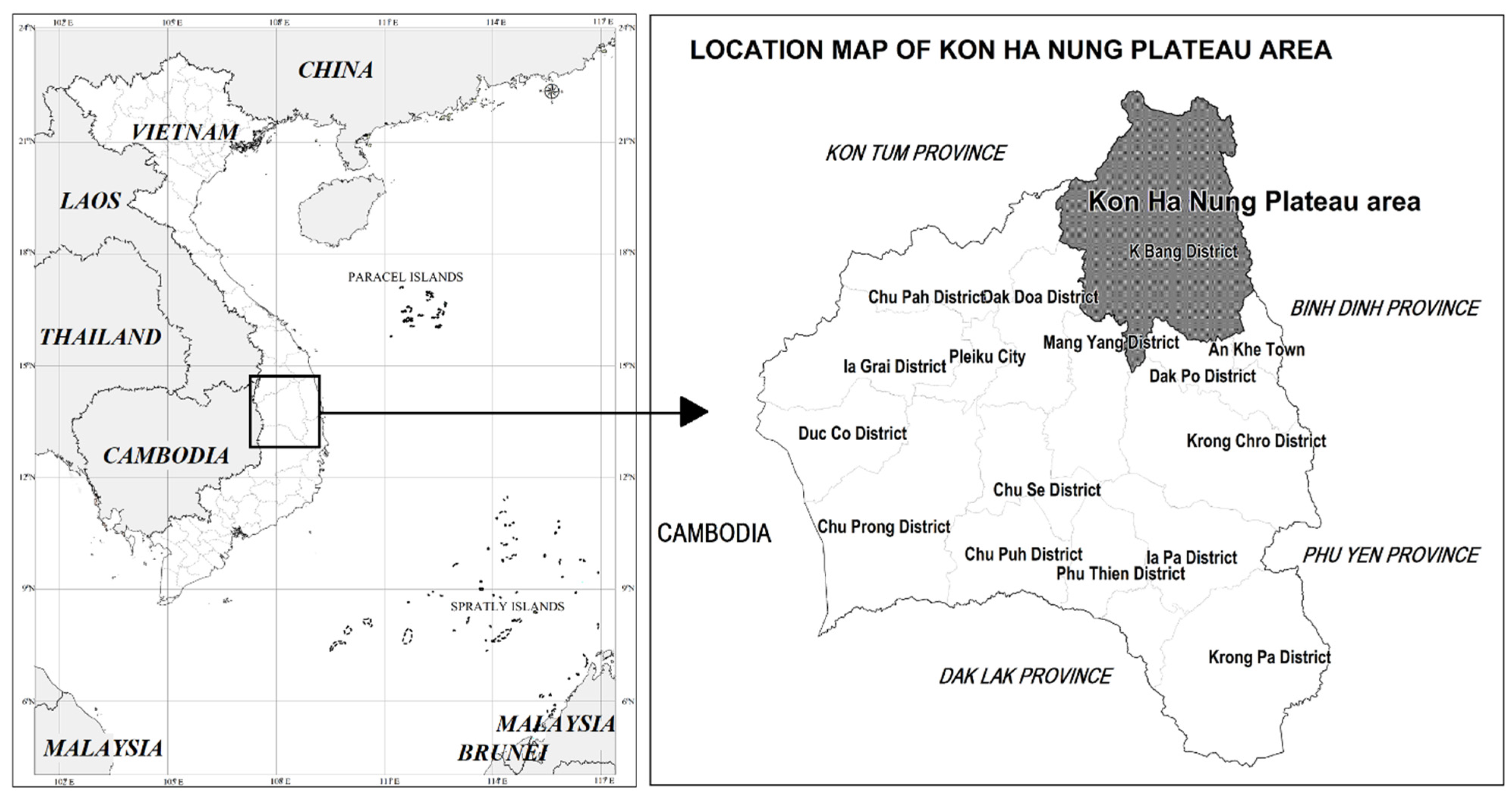

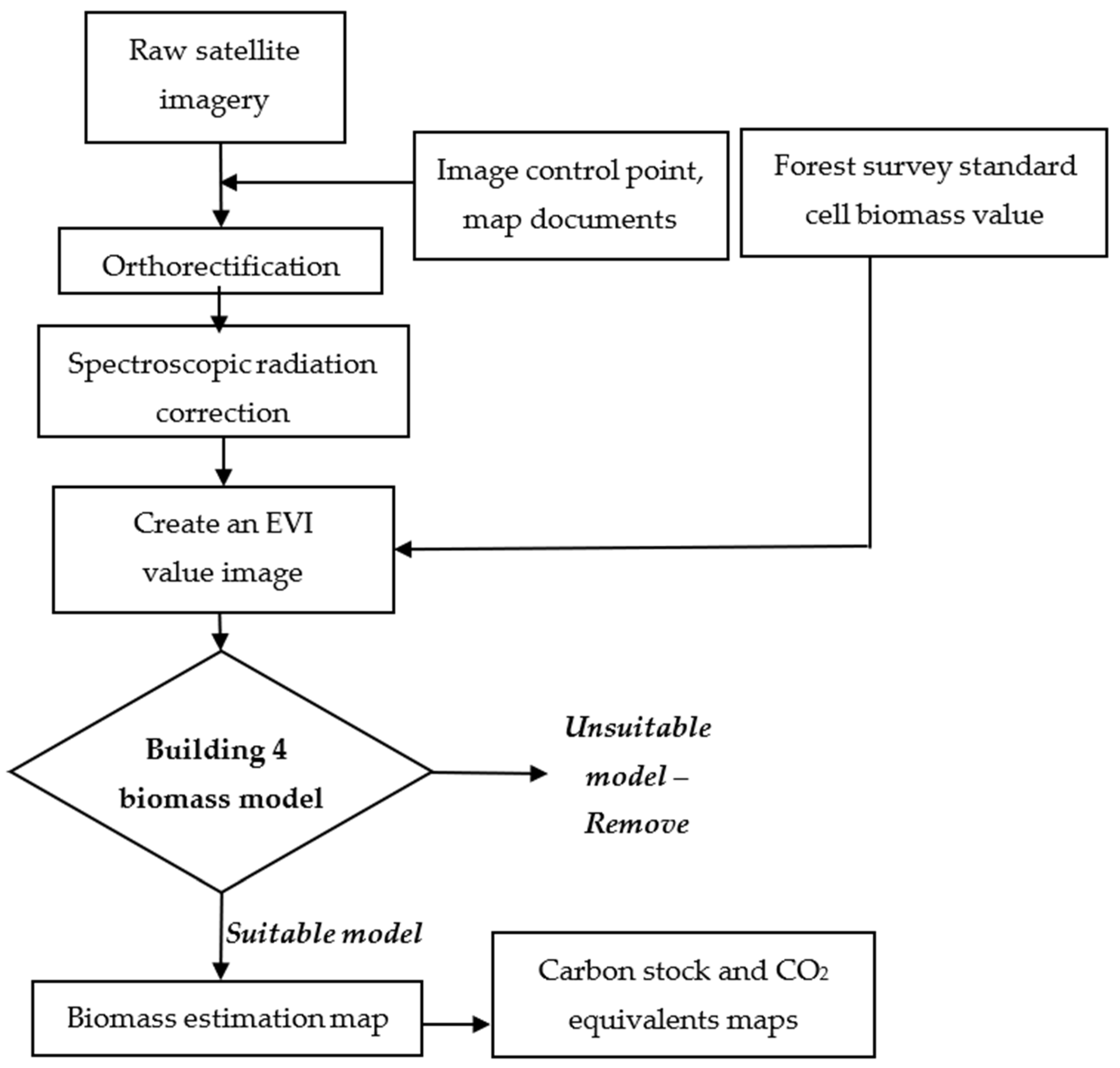



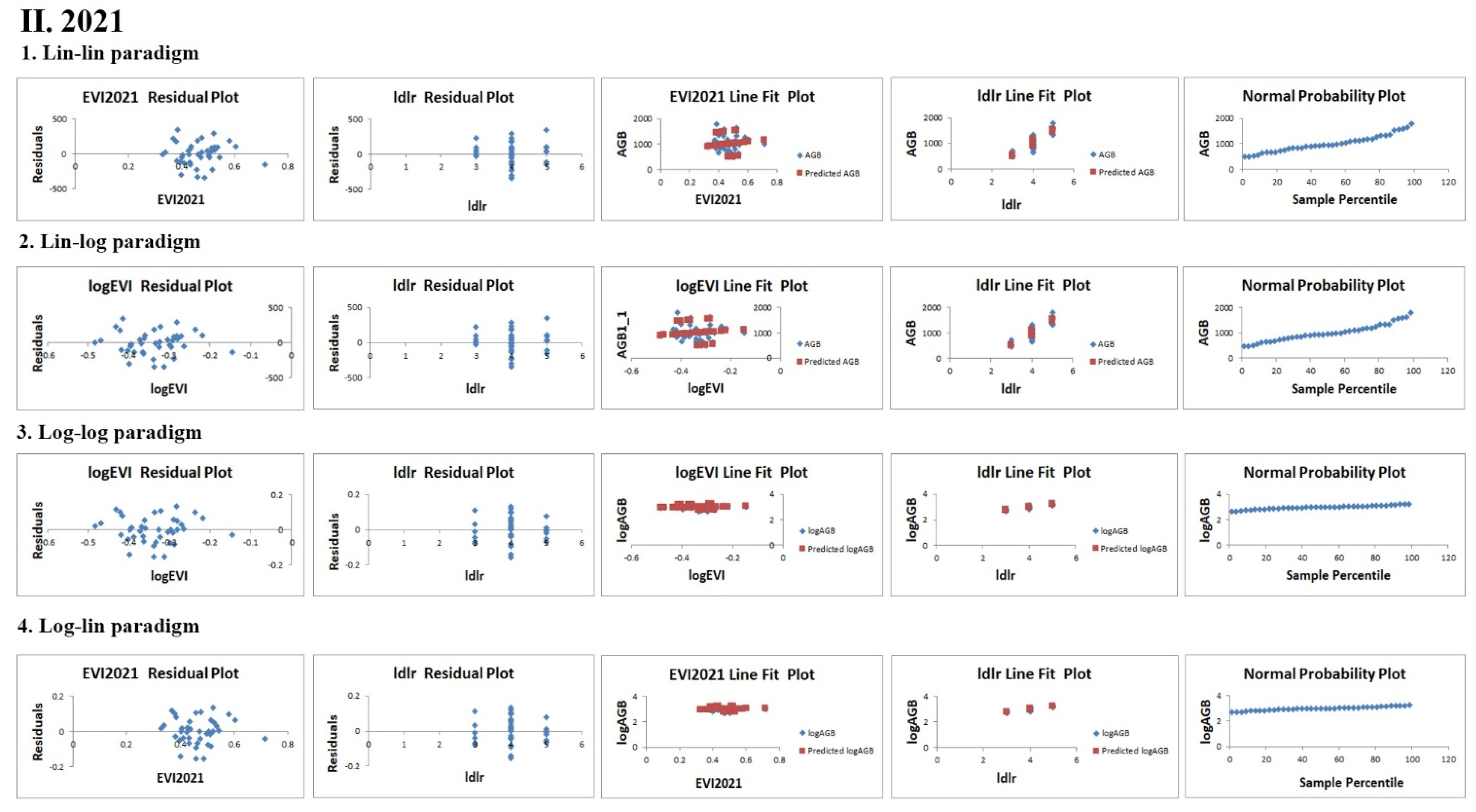
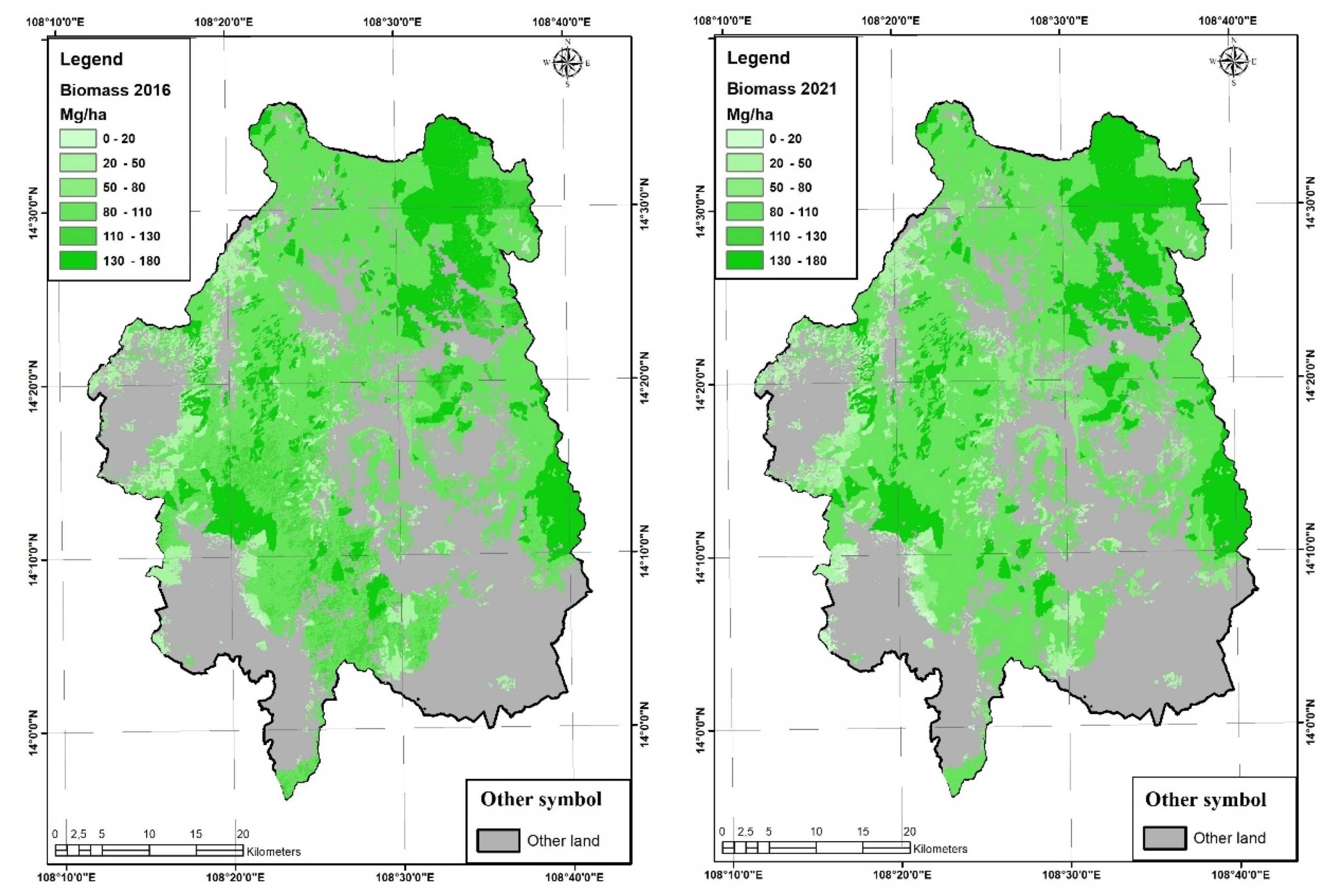
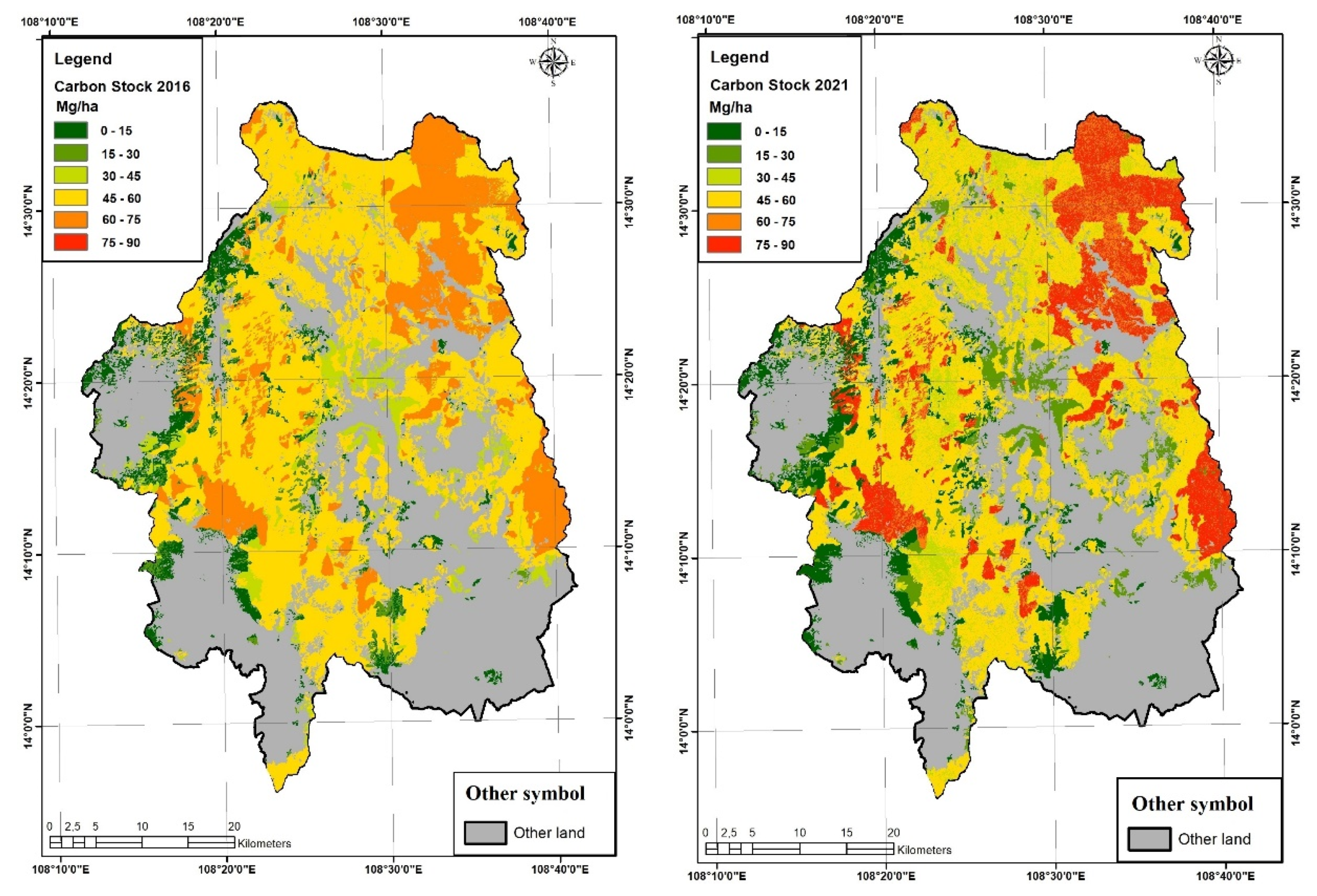
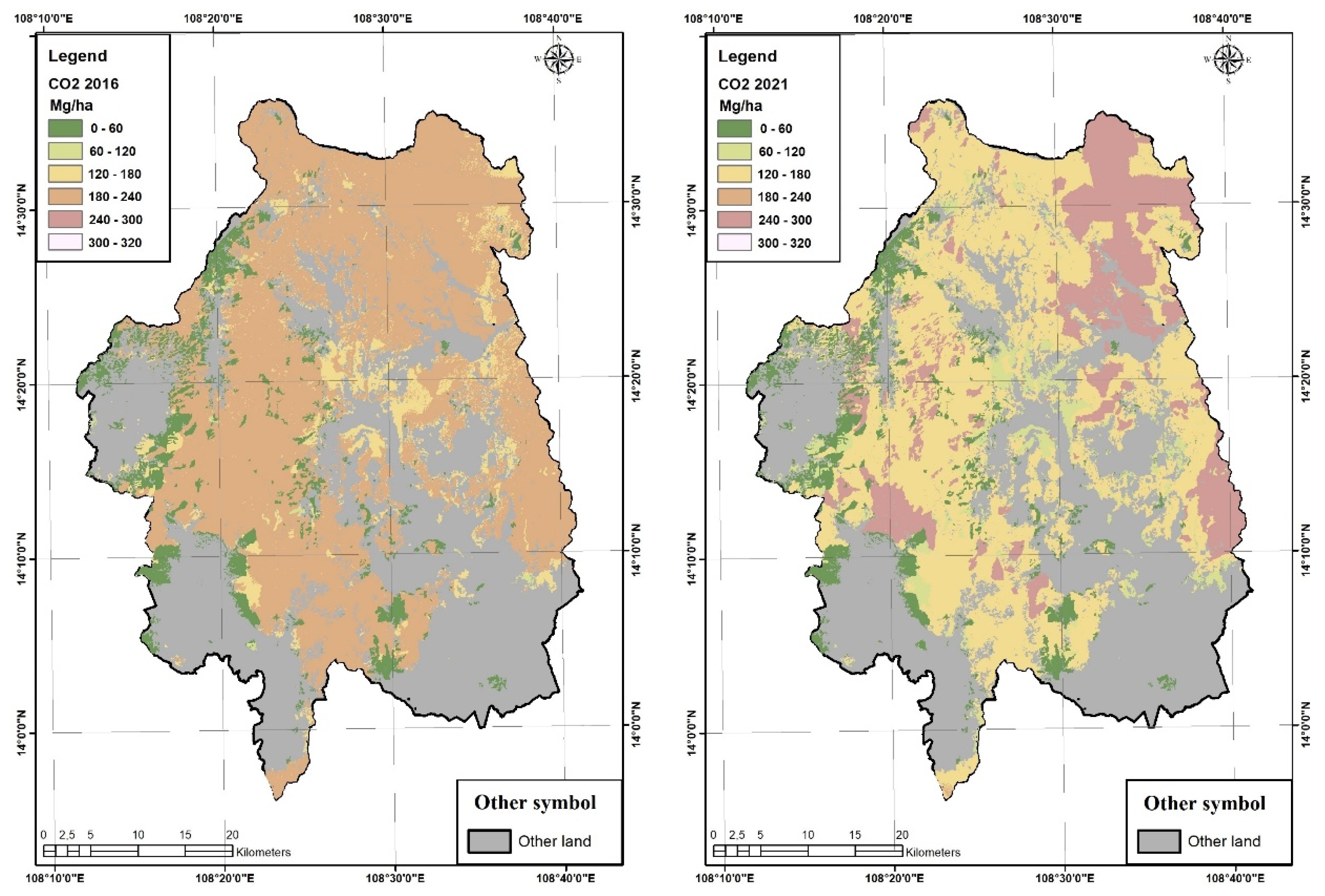
| Date | Sensor | Image Bands | Resolution |
|---|---|---|---|
| 13/02/2016 | Sentinel-2 | Blue (0.455–0.525 µm), Green (0.530–0.590 µm), Red (0.625–0.695 µm), Near-Infrared (0.760–0.890 µm) | Panchromatic: 10 m × 10 m Multispectral: 20 m × 20 m |
| 16/02/2021 | Sentinel-2 | Blue (0.455–0.525 µm), Green (0.530–0.590 µm), Red (0.625–0.695 µm), Near-Infrared (0.760–0.890 µm) | Panchromatic: 10 m × 10 m Multispectral: 20 m × 20 m |
| № | ldlr | Forest Type | Reserves | Weighting |
|---|---|---|---|---|
| 1 | RLP | Natural wood forests of mountainous land with evergreen broadleaf forest restored | Forest restoration | 1 |
| 2 | TXP | Evergreen broadleaf forest restored | Forest restoration | 1 |
| 3 | TNK | Natural bamboo forests of soil mountains | Very poor forests | 2 |
| 4 | TXK | Poor evergreen broadleaf natural timber forests | Very poor forests | 2 |
| 5 | TXN | Natural timber forests of mountainous land with poor evergreen broadleaf lands | Poor forests | 3 |
| 6 | RKB | Mountain coniferous forest with medium reserves | Medium forest | 4 |
| 7 | TXB | Natural timber forests on mountainous land with medium evergreen broadleaves | Medium forest | 4 |
| 8 | TXG | Natural timber forest in mountains with rich evergreen broadleaf land | Rich forest | 5 |
| Name | Paradigm | R2 | RMSE |
|---|---|---|---|
| Log-Log Paradigm | log10(AGB) = −1.5 × log10(EVI 2016) + 0.12 × ldlr + 2.00 | 0.62 | 0.021 |
| Log-Lin Paradigm | log10(AGB) = −1.19 × EVI 2016 + 0.12 × ldlr − 3.08 | 0.60 | 0.020 |
| Lin-Log Paradigm | AGB = −1370.8 × log10(EVI 2016) + 217.11 × ldlr − 223.22 | 0.76 | 21.24 |
| Lin-Lin Paradigm | AGB = −1028.7 × EVI 2016 + 218.57 × ldlr − 706.03 | 0.74 | 20.89 |
| Forest Survey Cell Number | Field Data (MTĐ) | Component Model (MAH) | dM = MTĐ − MAH | Forest Survey Cell Number | Field Data (MTĐ) | Component Model (MAH) | dM = MTĐ − MAH |
|---|---|---|---|---|---|---|---|
| 1 | 99.242 | 103.742 | −4.500 | 11 | 118.252 | 111.099 | 7.153 |
| 2 | 106.111 | 112.233 | −6.122 | 12 | 144.594 | 126.758 | 17.837 |
| 3 | 22.869 | 29.946 | −7.077 | 13 | 155.022 | 132.560 | 22.462 |
| 4 | 12.916 | 34.313 | −21.397 | 14 | 26.351 | 69.342 | −42.991 |
| 5 | 55.255 | 80.952 | −25.698 | 15 | 56.592 | 86.118 | −29.526 |
| 6 | 61.296 | 35.082 | 26.214 | 16 | 64.668 | 76.934 | −12.266 |
| 7 | 28.668 | 28.170 | 0.498 | 17 | 58.067 | 33.822 | 24.245 |
| 8 | 10.128 | 27.996 | −17.867 | 18 | 60.495 | 41.161 | 19.334 |
| 9 | 119.860 | 108.558 | 11.302 | 19 | 61.378 | 26.528 | 34.850 |
| 10 | 120.180 | 116.632 | 3.547 | ||||
| Total | 72.734 | 72.734 | |||||
| RMSE | 20.892 | ||||||
| MAE | 17.625 | ||||||
| R2 | 0.76 | ||||||
| Name | Paradigm | R2 | RMSE |
|---|---|---|---|
| Log-Log Paradigm | log10(AGB) = 0.29 × log10(EVI 2021) + 0.23 × ldlr + 2.16 | 0.758 | 0.08 |
| Log-Lin Paradigm | log10(AGB) = 0.28 × EVI 2021 + 0.23 × ldlr + 1.93 | 0.761 | 0.07 |
| Lin-Log Paradigm | AGB = 701.8 × log10(EVI 2021) + 508.9 × ldlr − 807.2 | 0.765 | 16.12 |
| Lin-Lin Paradigm | AGB = 646.0 × EVI 2021 + 508.2 × ldlr − 1342.01 | 0.762 | 16.10 |
| Forest Survey Cell Number | Field Data (MTĐ) | Component Model (MAH) | dM = MTĐ − MAH | Forest Survey Cell Number | Field Data (MTĐ) | Component Model (MAH) | dM = MTĐ − MAH |
|---|---|---|---|---|---|---|---|
| 1 | 151.666 | 147.584 | 4.082 | 23 | 62.379 | 52.927 | 9.452 |
| 2 | 179.189 | 144.597 | 34.592 | 24 | 93.431 | 89.943 | 3.488 |
| 3 | 82.716 | 95.643 | −12.928 | 25 | 95.811 | 96.944 | −1.132 |
| 4 | 93.431 | 95.241 | −1.810 | 26 | 118.235 | 99.142 | 19.093 |
| 5 | 115.634 | 92.497 | 23.136 | 27 | 118.548 | 107.476 | 11.073 |
| 6 | 84.423 | 97.163 | −12.740 | 28 | 125.530 | 106.208 | 19.322 |
| 7 | 65.031 | 94.883 | −29.851 | 29 | 89.629 | 88.954 | 0.675 |
| 8 | 104.404 | 97.402 | 7.002 | 30 | 75.692 | 99.039 | −23.347 |
| 9 | 80.023 | 102.603 | −22.580 | 31 | 65.531 | 99.093 | −33.562 |
| 10 | 66.722 | 100.859 | −34.137 | 32 | 108.740 | 103.170 | 5.570 |
| 11 | 83.449 | 93.452 | −10.003 | 33 | 132.236 | 103.040 | 29.196 |
| 12 | 132.919 | 148.186 | −15.267 | 34 | 111.167 | 102.523 | 8.645 |
| 13 | 134.061 | 145.508 | −11.447 | 35 | 72.245 | 49.341 | 22.904 |
| 14 | 163.309 | 153.968 | 9.341 | 36 | 96.484 | 102.033 | −5.549 |
| 15 | 94.475 | 99.950 | −5.475 | 37 | 99.385 | 104.256 | −4.871 |
| 16 | 47.608 | 48.492 | −0.884 | 38 | 99.862 | 112.605 | −12.742 |
| 17 | 51.052 | 49.289 | 1.762 | 39 | 156.238 | 153.256 | 2.983 |
| 18 | 90.370 | 95.047 | −4.676 | 40 | 62.379 | 52.927 | 9.452 |
| 19 | 111.737 | 93.294 | 18.443 | 41 | 93.431 | 89.943 | 3.488 |
| 20 | 159.021 | 148.423 | 10.597 | 42 | 95.811 | 96.944 | −1.132 |
| 21 | 55.366 | 50.644 | 4.721 | 43 | 118.235 | 99.142 | 19.093 |
| 22 | 47.919 | 50.994 | −3.075 | 44 | 118.548 | 107.476 | 11.073 |
| Total | 100.402 | 100.402 | |||||
| RMSE | 16.118 | ||||||
| MAE | 12.612 | ||||||
| R2 | 0.765 | ||||||
| Biomass Value (Mg/ha) | 0–20 | 20–50 | 50–80 | 80–110 | 110–130 | 130–180 | |
|---|---|---|---|---|---|---|---|
| 2016 | area (ha) | 1030.28 | 14,768.66 | 3038.61 | 86,377.44 | 13,941.46 | 30,126.35 |
| % | 0.69 | 9.85 | 2.03 | 58.05 | 9.30 | 20.09 | |
| 2021 | area (ha) | 2375.05 | 13,732.54 | 10,190.75 | 89,242.08 | 78.85 | 33,663.53 |
| % | 1.58 | 9.16 | 6.80 | 59.51 | 0.51 | 22.45 | |
| Carbon Stock Value (Mg/ha) | 0–15 | 15–30 | 30–45 | 45–60 | 60–75 | 75–90 | |
|---|---|---|---|---|---|---|---|
| 2016 | area (ha) | 12,333.5 | 3939.65 | 9737.48 | 90,082.55 | 33,189.62 | 0 |
| % | 8.22 | 2.63 | 6.49 | 60.52 | 22.13 | 0.00 | |
| 2021 | area (ha) | 15,002.6 | 10,324.22 | 20,991.8 | 69,288.01 | 9943.58 | 23,732.57 |
| % | 10.00 | 6.88 | 14.00 | 46.20 | 7.09 | 15.83 | |
| CO2 equivalents value (Mg/ha) | 0–60 | 60–120 | 120–180 | 180–240 | 240–300 | 300–320 | |
| 2016 | area (ha) | 15,729.6 | 593.73 | 16,277.84 | 116,681.66 | 0 | 0 |
| % | 10.49 | 0.40 | 10.85 | 78.26 | 0.00 | 0.00 | |
| 2021 | area (ha) | 15,099.1 | 10,492.11 | 89,589.17 | 510.25 | 33,574.43 | 17.77 |
| % | 10.07 | 7.00 | 59.74 | 0.34 | 22.84 | 0.01 | |
Publisher’s Note: MDPI stays neutral with regard to jurisdictional claims in published maps and institutional affiliations. |
© 2022 by the authors. Licensee MDPI, Basel, Switzerland. This article is an open access article distributed under the terms and conditions of the Creative Commons Attribution (CC BY) license (https://creativecommons.org/licenses/by/4.0/).
Share and Cite
Dang, H.N.; Ba, D.D.; Trung, D.N.; Viet, H.N.H. A Novel Method for Estimating Biomass and Carbon Sequestration in Tropical Rainforest Areas Based on Remote Sensing Imagery: A Case Study in the Kon Ha Nung Plateau, Vietnam. Sustainability 2022, 14, 16857. https://doi.org/10.3390/su142416857
Dang HN, Ba DD, Trung DN, Viet HNH. A Novel Method for Estimating Biomass and Carbon Sequestration in Tropical Rainforest Areas Based on Remote Sensing Imagery: A Case Study in the Kon Ha Nung Plateau, Vietnam. Sustainability. 2022; 14(24):16857. https://doi.org/10.3390/su142416857
Chicago/Turabian StyleDang, Hoi Nguyen, Duy Dinh Ba, Dung Ngo Trung, and Hieu Nguyen Huu Viet. 2022. "A Novel Method for Estimating Biomass and Carbon Sequestration in Tropical Rainforest Areas Based on Remote Sensing Imagery: A Case Study in the Kon Ha Nung Plateau, Vietnam" Sustainability 14, no. 24: 16857. https://doi.org/10.3390/su142416857
APA StyleDang, H. N., Ba, D. D., Trung, D. N., & Viet, H. N. H. (2022). A Novel Method for Estimating Biomass and Carbon Sequestration in Tropical Rainforest Areas Based on Remote Sensing Imagery: A Case Study in the Kon Ha Nung Plateau, Vietnam. Sustainability, 14(24), 16857. https://doi.org/10.3390/su142416857






